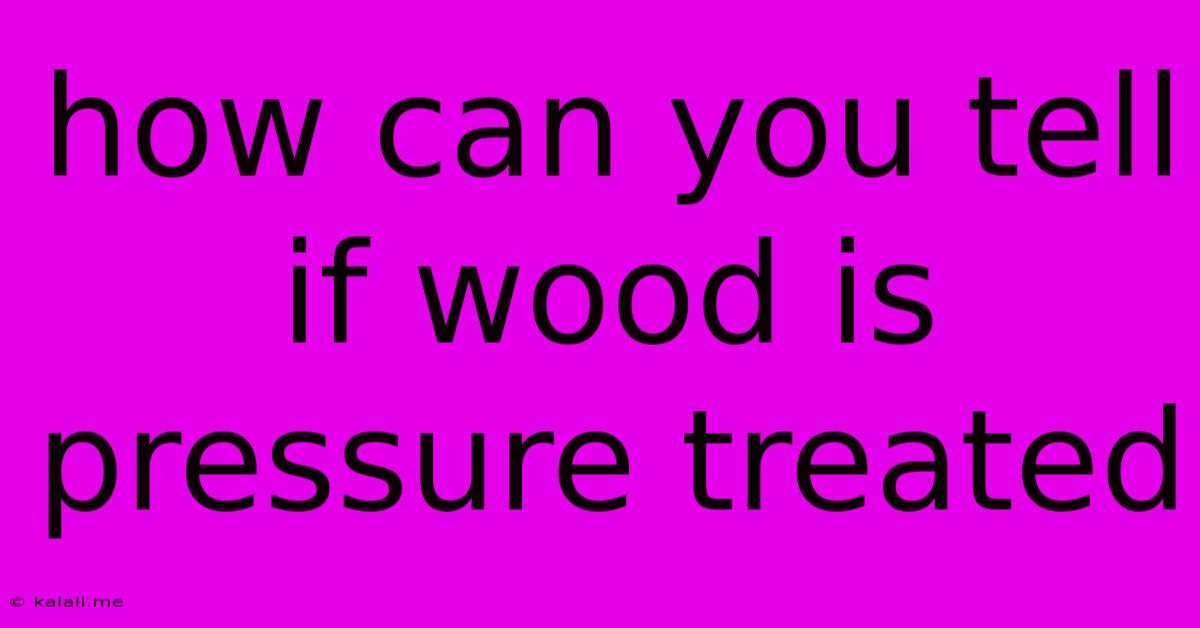How Can You Tell If Wood Is Pressure Treated
Kalali
Jun 07, 2025 · 3 min read

Table of Contents
How Can You Tell if Wood is Pressure Treated?
Identifying pressure-treated wood is crucial for safety and proper application. Pressure-treated lumber, often used in outdoor projects due to its resistance to rot, decay, and insect infestation, contains chemical preservatives. Knowing how to identify this treated wood helps ensure you’re using the right material for your project and avoiding potential health hazards. This guide will help you determine if your wood has undergone pressure treatment.
Visual Inspection: The Clues Your Eyes Can See
While not foolproof, visual inspection can provide initial clues. Look for these characteristics:
-
Color: Pressure-treated wood often has a distinctive greenish tint, though this can vary depending on the preservative used. Older treated lumber may appear more gray or weathered. The color isn't a definitive indicator, however, as some naturally occurring wood species also exhibit green hues. Don't rely solely on color.
-
Stamp or Mark: Reputable manufacturers usually stamp or brand the lumber to indicate pressure treatment. Look for labels, stamps, or brands containing information such as the type of preservative used (e.g., CCA, CA-B, ACQ) or a statement confirming pressure treatment. These markings are typically found on the ends of the lumber.
-
Texture: Pressure treatment can slightly alter the wood's texture. It may feel slightly rougher or less smooth than untreated lumber. However, this is subtle and not a reliable indicator on its own.
Beyond Sight: More Reliable Methods
Visual inspection alone isn't sufficient to confidently determine if wood is pressure treated. These methods offer more certainty:
-
Smell: Some preservatives, particularly older CCA-treated lumber (chromated copper arsenate), have a distinct, somewhat pungent odor. However, newer preservatives often have a less noticeable scent, making this an unreliable method for identifying modern pressure-treated wood. Furthermore, relying on smell is not a safe way to assess the wood’s treatment.
-
Density: Pressure-treated wood tends to be slightly denser than untreated wood, though this difference can be difficult to detect without specialized tools.
-
Professional Testing: For absolute certainty, you can contact a qualified laboratory or lumber testing facility. They possess the tools and expertise to definitively determine the presence and type of wood preservative. This is the most reliable method but involves cost and time.
Understanding Preservative Types
The type of preservative used also influences identification. Common types include:
-
CCA (Chromated Copper Arsenate): This was a common preservative in the past but its use has largely been phased out due to arsenic concerns. If you encounter CCA-treated wood, handle it with caution and wear appropriate protective gear.
-
ACQ (Alkaline Copper Quaternary): This is a widely used, environmentally friendly alternative to CCA. It typically results in a greenish hue.
-
CA-B (Copper Azole): Another environmentally preferred alternative with similar characteristics to ACQ.
Safety Precautions When Working with Pressure-Treated Wood
Regardless of the identification method, always prioritize safety when working with pressure-treated lumber:
-
Wear gloves and eye protection: This is crucial to protect your skin and eyes from potential irritants.
-
Ensure adequate ventilation: Work in a well-ventilated area or outdoors whenever possible.
-
Wash your hands thoroughly after handling: This helps remove any residual chemicals.
By utilizing a combination of visual inspection and other techniques, you can significantly improve your ability to tell if wood is pressure treated. Remember, however, that professional testing provides the most definitive results when dealing with critical projects or when safety is paramount. Always prioritize safety and use appropriate protective gear when handling any potentially treated wood.
Latest Posts
Latest Posts
-
Failed To Start Docker Service Unit Not Found
Jun 07, 2025
-
Im Using Booleen Union Tol And The Object Keeps Disa
Jun 07, 2025
-
Are Song Lyrics Considered Unconventional Literature
Jun 07, 2025
-
Can You Use A Bass Amp For Guitar
Jun 07, 2025
-
Can Mold Grow On Stainless Steel
Jun 07, 2025
Related Post
Thank you for visiting our website which covers about How Can You Tell If Wood Is Pressure Treated . We hope the information provided has been useful to you. Feel free to contact us if you have any questions or need further assistance. See you next time and don't miss to bookmark.